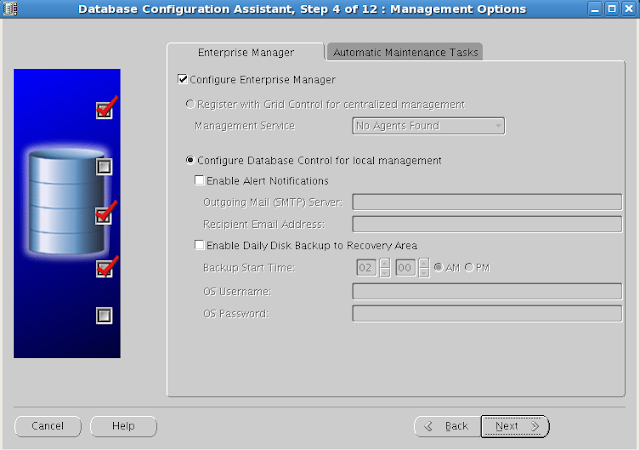Oracle has officially announced 12c database on 10th of july . This 12 c database is having around 500 new features and according to Oracle Corp this is true cloud database. Whatever, we will see the demonstration of some new features of 12c database in coming posts . Here i am going to show you how you can move a datafile which is online .
Before 12c database you needed to make the tablespace offline while moving any of its datafile .
But from 12c release you can move datafile while its online .
SQL> col file_name for a70
SQL> set lines 200
SQL> select file_name,tablespace_name from dba_data_files;
FILE_NAME TABLESPACE_NAME
-------------------------------------------------- ------------------
/data1/oradata/orcl/system01.dbf SYSTEM
/data1/oradata/orcl/sysaux01.dbf SYSAUX
/data1/oradata/orcl/users01.dbf USERS
/data1/oradata/orcl/undotbs01.dbf UNDOTBS1
SQL> alter database move datafile '/data1/oradata/orcl/users01.dbf' to '/data2/oradata/orcl/users01.dbf';
Database altered.
SQL> select file_name,tablespace_name from dba_data_files;
FILE_NAME TABLESPACE_NAME
---------------------------------------------------- ------------------
/data1/oradata/orcl/undotbs01.dbf UNDOTBS1
/data1/oradata/orcl/sysaux01.dbf SYSAUX
/data1/oradata/orcl/system01.dbf SYSTEM
/data2/oradata/orcl/users01.dbf USERS
This is what got recorded in alert log about this operation
alter database move datafile '/data1/oradata/orcl/users01.dbf' to '/data2/oradata/orcl/users01.dbf'
Tue Jul 16 00:42:51 2013
Moving datafile /data1/oradata/orcl/users01.dbf (6) to /data2/oradata/orcl/users01.dbf
Move operation committed for file /data2/oradata/orcl/users01.dbf
Completed: alter database move datafile '/data1/oradata/orcl/users01.dbf' to '/data2/oradata/orcl/users01.dbf'
EVEN YOU CAN MOVE SYSTEM DATAFILE TOO.......
SQL> col file_name for a70
SQL> set lines 200
SQL> select file_name,tablespace_name from dba_data_files;
FILE_NAME TABLESPACE_NAME
----------------------------------------------------- ---------------------
/data1/oradata/orcl/undotbs01.dbf UNDOTBS1
/data1/oradata/orcl/sysaux01.dbf SYSAUX
/data1/oradata/orcl/system01.dbf SYSTEM
/data2/oradata/orcl/users01.dbf USERS
SQL> alter database move datafile '/data1/oradata/orcl/system01.dbf' to '/data2/oradata/orcl/system01.dbf';
Database altered.
SQL> select file_name,tablespace_name from dba_data_files;
FILE_NAME TABLESPACE_NAME
------------------------------------------------- -------------------
/data2/oradata/orcl/system01.dbf SYSTEM
/data1/oradata/orcl/undotbs01.dbf UNDOTBS1
/data1/oradata/orcl/sysaux01.dbf SYSAUX
/data2/oradata/orcl/users01.dbf USERS
This is what got recorded in alert log about this operation
Tue Jul 16 00:51:17 2013
alter database move datafile '/data1/oradata/orcl/system01.dbf' to '/data2/oradata/orcl/system01.dbf'
Tue Jul 16 00:51:17 2013
Moving datafile /data1/oradata/orcl/system01.dbf (1) to /data2/oradata/orcl/system01.dbf
Tue Jul 16 00:52:10 2013
Move operation committed for file /data2/oradata/orcl/system01.dbf
Completed: alter database move datafile '/data1/oradata/orcl/system01.dbf' to '/data2/oradata/orcl/system01.dbf'
Before 12c database you needed to make the tablespace offline while moving any of its datafile .
But from 12c release you can move datafile while its online .
SQL> col file_name for a70
SQL> set lines 200
SQL> select file_name,tablespace_name from dba_data_files;
FILE_NAME TABLESPACE_NAME
-------------------------------------------------- ------------------
/data1/oradata/orcl/system01.dbf SYSTEM
/data1/oradata/orcl/sysaux01.dbf SYSAUX
/data1/oradata/orcl/users01.dbf USERS
/data1/oradata/orcl/undotbs01.dbf UNDOTBS1
SQL> alter database move datafile '/data1/oradata/orcl/users01.dbf' to '/data2/oradata/orcl/users01.dbf';
Database altered.
SQL> select file_name,tablespace_name from dba_data_files;
FILE_NAME TABLESPACE_NAME
---------------------------------------------------- ------------------
/data1/oradata/orcl/undotbs01.dbf UNDOTBS1
/data1/oradata/orcl/sysaux01.dbf SYSAUX
/data1/oradata/orcl/system01.dbf SYSTEM
/data2/oradata/orcl/users01.dbf USERS
This is what got recorded in alert log about this operation
alter database move datafile '/data1/oradata/orcl/users01.dbf' to '/data2/oradata/orcl/users01.dbf'
Tue Jul 16 00:42:51 2013
Moving datafile /data1/oradata/orcl/users01.dbf (6) to /data2/oradata/orcl/users01.dbf
Move operation committed for file /data2/oradata/orcl/users01.dbf
Completed: alter database move datafile '/data1/oradata/orcl/users01.dbf' to '/data2/oradata/orcl/users01.dbf'
EVEN YOU CAN MOVE SYSTEM DATAFILE TOO.......
SQL> col file_name for a70
SQL> set lines 200
SQL> select file_name,tablespace_name from dba_data_files;
FILE_NAME TABLESPACE_NAME
----------------------------------------------------- ---------------------
/data1/oradata/orcl/undotbs01.dbf UNDOTBS1
/data1/oradata/orcl/sysaux01.dbf SYSAUX
/data1/oradata/orcl/system01.dbf SYSTEM
/data2/oradata/orcl/users01.dbf USERS
SQL> alter database move datafile '/data1/oradata/orcl/system01.dbf' to '/data2/oradata/orcl/system01.dbf';
Database altered.
SQL> select file_name,tablespace_name from dba_data_files;
FILE_NAME TABLESPACE_NAME
------------------------------------------------- -------------------
/data2/oradata/orcl/system01.dbf SYSTEM
/data1/oradata/orcl/undotbs01.dbf UNDOTBS1
/data1/oradata/orcl/sysaux01.dbf SYSAUX
/data2/oradata/orcl/users01.dbf USERS
This is what got recorded in alert log about this operation
Tue Jul 16 00:51:17 2013
alter database move datafile '/data1/oradata/orcl/system01.dbf' to '/data2/oradata/orcl/system01.dbf'
Tue Jul 16 00:51:17 2013
Moving datafile /data1/oradata/orcl/system01.dbf (1) to /data2/oradata/orcl/system01.dbf
Tue Jul 16 00:52:10 2013
Move operation committed for file /data2/oradata/orcl/system01.dbf
Completed: alter database move datafile '/data1/oradata/orcl/system01.dbf' to '/data2/oradata/orcl/system01.dbf'






































































